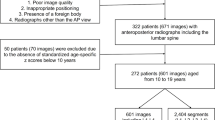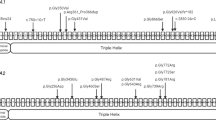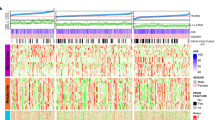Abstract
Osteogenesis Imperfecta (OI) is a clinically and genetically heterogeneous group of diseases characterized by brittle bones. Though genetic mutations in COL1A1 and COL1A2 account for approximately 85–90% of OI cases, there are now more than twenty genes described, responsible for rare forms of OI. Treatment is based on the use of bisphosphonates and though it is well established that they increase lumbar spine (LS) bone mineral density (BMD), the clinical impact on fracture reduction is still debated.
In this study, we investigated the clinical characteristics of 38 patients with a bone fragility disorder that had variants in non-COL1A1/COL1A2 genes in order to study genotype-phenotype correlations, as the natural history of these rare forms is still not well known. We then studied the usefulness of bisphosphonate treatment by evaluating the effects on LS BMD, annual non-vertebral fracture rate, bone turnover markers and height. This study enabled us to better define the natural history of patients with non-COL1 pathogenic variants. Patients with CRTAP and TMEM38B variants consistently had a prenatal presentation with a short (<3rd p) and bowed femur. Importantly, this prenatal involvement does not predict the postnatal severity of the disease. Regarding treatment by bisphosphonates, all patients showed a significant increase in LS BMD while treated and this increase was dependent on the dose received. The increase in LS BMD also translated in a reduction of fracture rate during treatment. Finally, our study showed that the earlier bisphosphonates are initiated, the greater the fracture rate is reduced.
This is a preview of subscription content, access via your institution
Access options
Subscribe to this journal
Receive 12 print issues and online access
$259.00 per year
only $21.58 per issue
Buy this article
- Purchase on SpringerLink
- Instant access to full article PDF
Prices may be subject to local taxes which are calculated during checkout



Similar content being viewed by others
Data availability
The datasets generated and analyzed during the current study are available from the corresponding author on reasonable request.
References
Bardai G, Moffatt P, Glorieux FH, Rauch F. DNA sequence analysis in 598 individuals with a clinical diagnosis of osteogenesis imperfecta: diagnostic yield and mutation spectrum. Osteoporos Int 2016;27:3607–13.
Castillo H, Samson-Fang L. American Academy for Cerebral Palsy and Developmental Medicine Treatment Outcomes Committee Review Panel. Effects of bisphosphonates in children with osteogenesis imperfecta: an AACPDM systematic review. Dev Med Child Neurol 2009;51:17–29.
Palomo T, Fassier F, Ouellet J, Sato A, Montpetit K, Glorieux FH, et al. Intravenous bisphosphonate therapy of young children with osteogenesis imperfecta: skeletal findings during follow up throughout the growing years. J Bone Miner Res. 2015;30:2150–7.
Shaw NJ, Bishop NJ. Bisphosphonate treatment of bone disease. Arch Dis Child 2005;90:494–9.
Bleck EE. Nonoperative treatment of osteogenesis imperfecta: orthotic and mobility management. Clin. Orthop. Relat. Res. 1981;111–22.
Morello R, Bertin TK, Chen Y, Hicks J, Tonachini L, Monticone M, et al. CRTAP is required for prolyl 3- hydroxylation and mutations cause recessive osteogenesis imperfecta. Cell. 2006;127:291–304.
Barnes AM, Chang W, Morello R, Cabral WA, Weis M, Eyre DR, et al. Deficiency of cartilage-associated protein in recessive lethal osteogenesis imperfecta. N. Engl J Med. 2006;355:2757–64.
Marini JC, Cabral WA, Barnes AM. Null mutations in LEPRE1 and CRTAP cause severe recessive osteogenesis imperfecta. Cell Tissue Res. 2010;339:59–70.
Amor IMB, Rauch F, Gruenwald K, Weis M, Eyre DR, Roughley P, et al. Severe osteogenesis imperfecta caused by a small in-frame deletion in CRTAP. Am J Med Genet A. 2011;155A:2865–70.
Tang Y-A, Wang L-Y, Chang C-M, Lee I-W, Tsai W-H, Sun HS. Novel compound heterozygous mutations in cause rare autosomal recessive osteogenesis imperfecta. Front Genet. 2020;11:897.
Glorieux FH, Ward LM, Rauch F, Lalic L, Roughley PJ, Travers R. Osteogenesis imperfecta type VI: a form of brittle bone disease with a mineralization defect. J Bone Miner Res. 2002;17:30–8.
Becker J, Semler O, Gilissen C, Li Y, Bolz HJ, Giunta C, et al. Exome sequencing identifies truncating mutations in human SERPINF1 in autosomal-recessive osteogenesis imperfecta. Am J Hum Genet. 2011;88:362–71.
Venturi G, Gandini A, Monti E, Dalle Carbonare L, Corradi M, et al. Lack of expression of SERPINF1, the gene coding for pigment epithelium-derived factor, causes progressively deforming osteogenesis imperfecta with normal type I collagen. J Bone Miner Res. 2012;27:723–8.
Homan EP, Rauch F, Grafe I, Lietman C, Doll JA, Dawson B, et al. Mutations in SERPINF1 cause osteogenesis imperfecta type VI. J Bone Miner Res. 2011;26:2798–803.
Caparrós-Martin JA, Valencia M, Pulido V, Martínez-Glez V, Rueda-Arenas I, Amr K, et al. Clinical and molecular analysis in families with autosomal recessive osteogenesis imperfecta identifies mutations in five genes and suggests genotype-phenotype correlations. Am J Med Genet A. 2013;161A:1354–69.
Jin Z, Burrage LC, Jiang M-M, Lee Y-C, Bertin T, Chen Y, et al. Whole-exome sequencing identifies an intronic cryptic splice site in causing osteogenesis imperfecta type VI. JBMR. 2018;2:235–9.
Trejo P, Palomo T, Montpetit K, Fassier F, Sato A, Glorieux FH, et al. Long-term follow-up in osteogenesis imperfecta type VI. Osteoporos Int. 2017;28:2975–83.
Celik NB, Gonc N, Ozon A, Alikasifoglu A, Rauch F, Kandemir N. Treatment response to long term antiresorptive therapy in osteogenesis imperfecta type VI: does genotype matter? J Pediatr Endocrinol Metab. 2020;33:1617–24.
Minillo RM, Sobreira N, de Faria Soares M, de F, Jurgens J, Ling H, et al. Novel deletion of SERPINF1 causes autosomal recessive osteogenesis imperfecta type VI in two Brazilian families. Mol Syndromol. 2014;5:268–75.
Hoyer-Kuhn H, Netzer C, Koerber F, Schoenau E, Semler O. Two years’ experience with denosumab for children with osteogenesis imperfecta Type VI. Orphanet J Rare Dis. 2014;9:145.
Tucker T, Nelson T, Sirrs S, Roughley P, Glorieux FH, Moffatt P, et al. A co-occurrence of osteogenesis imperfecta type VI and cystinosis. Am J Med Genet A. 2012;158A:1422–6.
Cho SY, Ki C-S, Sohn YB, Kim SJ, Maeng SH, Jin D-K. Osteogenesis imperfecta Type VI with severe bony deformities caused by novel compound heterozygous mutations in SERPINF1. J Korean Med Sci. 2013;28:1107–10.
Land C, Rauch F, Travers R, Glorieux FH. Osteogenesis imperfecta type VI in childhood and adolescence: effects of cyclical intravenous Pamidronate treatment. Bone. 2007;40:638–44.
Dubail J, Brunelle P, Baujat G, Huber C, Doyard M, Michot C, et al. Homozygous loss-of-function mutations in CCDC134 are responsible for a severe form of osteogenesis imperfecta. J Bone Miner Res. 2020;35:1470–80.
Sakkers R, Kok D, Engelbert R, van Dongen A, Jansen M, Pruijs H, et al. Skeletal effects and functional outcome with olpadronate in children with osteogenesis imperfecta: a 2-year randomised placebo-controlled study. Lancet. 2004;363:1427–31.
Bishop N, Adami S, Ahmed SF, Antón J, Arundel P, Burren CP, et al. Risedronate in children with osteogenesis imperfecta: a randomised, double-blind, placebo-controlled trial. Lancet. 2013;382:1424–32.
Robinson M-E, Trejo P, Palomo T, Glorieux FH, Rauch F. Osteogenesis imperfecta: skeletal outcomes after bisphosphonate discontinuation at final height. J Bone Miner Res. 2019;34:2198–204.
Poyrazoglu S, Gunoz H, Darendeliler F, Bas F, Tutunculer F, Eryilmaz SK, et al. Successful results of Pamidronate treatment in children with osteogenesis imperfecta with emphasis on the interpretation of bone mineral density for local standards. J Pediatr Orthop. 2008;28:483–7.
Lindahl K, Kindmark A, Rubin C-J, Malmgren B, Grigelioniene G, Söderhäll S, et al. Decreased fracture rate, pharmacogenetics and BMD response in 79 Swedish children with osteogenesis imperfecta types I, III and IV treated with Pamidronate. Bone. 2016;87:11–8.
Mohsenzade P, Amirhakimi A, Honar N, Saki F, Omrani GHR, Dabbaghmanesh M. Bone density, fractures and the associated factors in iranian children and adolescent with Osteogenesis Imperfecta. BMC Pediatr. 2021;21:37.
Fleming F, Woodhead HJ, Briody JN, Hall J, Cowell CT, Ault J, et al. Cyclic bisphosphonate therapy in osteogenesis imperfecta type V. J Paediatr Child Health 2005;41:147–51.
Zeitlin L, Rauch F, Travers R, Munns C, Glorieux FH. The effect of cyclical intravenous Pamidronate in children and adolescents with osteogenesis imperfecta type V. Bone. 2006;38:13–20.
Funding
This research received no specific grant from any funding agency in the public, commercial, or not-for-profit sectors.
Author information
Authors and Affiliations
Contributions
MC conceived and designed the work that led to the submission, acquired data, played an important role in interpreting the results and drafted the manuscript. PB, GB, CM, JVG, BL, ES, EK, ZP, GP and SM contributed to data extraction. VCD conceived and designed the work that led to the submission, played an important role in interpreting the results. All contributing authors revised the manuscript, provided feedback and approved the final version.
Corresponding author
Ethics declarations
Competing interests
The authors declare no competing interests.
Ethical approval
This study was approved by the CER APHP ethics committee.
Additional information
Publisher’s note Springer Nature remains neutral with regard to jurisdictional claims in published maps and institutional affiliations.
Supplementary information
Rights and permissions
Springer Nature or its licensor (e.g. a society or other partner) holds exclusive rights to this article under a publishing agreement with the author(s) or other rightsholder(s); author self-archiving of the accepted manuscript version of this article is solely governed by the terms of such publishing agreement and applicable law.
About this article
Cite this article
Charpié, M., Brunelle, P., Baujat, G. et al. Clinical spectrum of rare bone fragility disorders and response to bisphosphonate treatment: a retrospective study. Eur J Hum Genet 32, 1559–1566 (2024). https://doi.org/10.1038/s41431-024-01645-4
Received:
Revised:
Accepted:
Published:
Issue date:
DOI: https://doi.org/10.1038/s41431-024-01645-4



